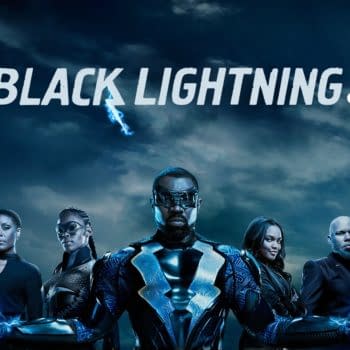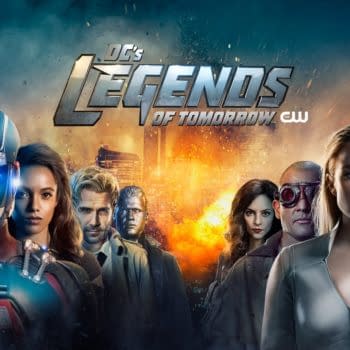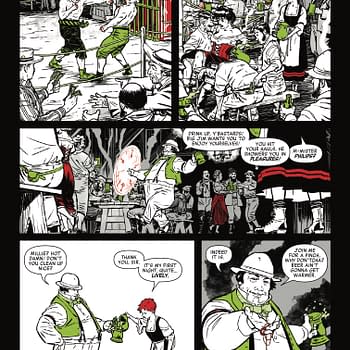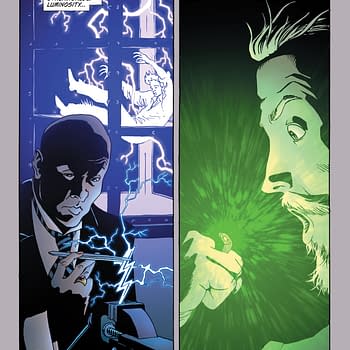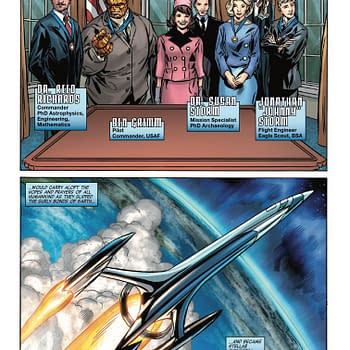Posted in: Comics | Tagged: Comics, david liss, dynamite, entertainment, Moriarty Lives, sherlock holmes, Troy Brownfield
"I Always Liked The Idea Of Writing About Villains Who Find Themselves In The Role Of The Hero." – David Liss Talks Moriarty
Novelist turned comic writer David Liss continues his Sherlock Holmes: Moriarty Lives series for Dynamite with it's penultimate chapter. He talks with writer Troy Brownfield and reveals where the idea for focusing on the great detective's arch-enemy came from and how he approaches writing a comic script versus prose.
TROY BROWNFIELD: Origin question! How did you first discover Sherlock Holmes, and did those stories have an impact on your development as writer?
DAVID LISS: Honestly, it's like asking someone when they first discovered crackers. Sherlock Holmes is so much a part of our culture, I think I was aware of him as a character before I'd ever read a story or seen a movie. And I think that, for me, the influence was more in this secondary manner. My exposure to the world of Holmes came initially from thinks that had been influenced by Doyle's writings.

DL: I think a lot of the same conceptualizing goes into the historical novels and the historical comics. In both media, I'm trying to convey a sense of time and place, and create conflicts and resolutions that are specific to the setting. In a lot of ways, it's much easier to write historical comics because I don't have to work as hard to get the period detail right. That becomes the artist's burden, so I can focus instead on character and story.

DL: I don't consciously put on my prose or comics hat when I sit down to work, though I know I approach the media differently. But rather than thinking, Oh, this is a comic, not a novel, so let me do this…. I consider the piece itself and what I want to get out of it. Obviously, expectations of medium and genre go into that, but I'm usually more focused on telling the best story I can and trying to have fun with it, rather consciously teasing out technical details.

DL: I knew I was going to be having a conversation with Nick Barrucci at Dynamite about possible future projects, and so I found myself thinking about the properties they currently have licensed. When I thought about Sherlock Holmes, I didn't feel like I wanted to write a story about the detective himself, but I always liked the idea of writing about villains who find themselves in a the role of hero, or, at least, anti-hero. I started thinking about ways I could do that with Moriarty, and then I pitched the concept. For some reason, they let me write it.

DL: When you have an archetypal villain like Moriarty, it's easy to see him as evil incarnate, but no one sees himself as the villain of his own story. I love getting into the heads of characters who are seen one way by the world, and showing how they see themselves. There's also a kind of freedom in having a known villain as the hero of the piece. You don't have to worry about restraining him or making sure he does the moral thing. In other words, I'm attracted to this kind of story because they're fun to read and write.
TB: In a number of comics, it seems awfully easy for a villain to become an anti-hero or even an outright hero over time. With Moriarty in the main character slot, did you have any worries about making him seem too sympathetic or even heroic in his actions?
DL: To be honest, I wasn't worried about the long-term implications for the character. I just wanted to develop him as fully as I could for this story. But like I said, I don't care how evil he has been or will be in the past. It doesn't mean he has to drown kittens and kick babies. He might love kittens and babies and still do terrible things and be able to justify them to himself. That contradiction is the essence of what makes a character interesting.

DL: I needed to come up with someone who would be a worthy rival for the "Napoleon of Crime," so I knew he had to be pretty intense. I just started playing around with ideas, and I came up with someone twisted and powerful and completely checked out of reality. In Moriarty's first appearance in "The Final Problem," Doyle describes him as methodical and planning and precise, so I thought it would be good to put him up against someone who is none of those things.
TB: Also at issue in this story is the relationship between Moriarty and the revenge-seeking boy, Udo. Some might blanch at Moriarty dealing with a child, but I find their interactions to be extremely interesting. Why introduce and emphasize that type of relationship?
DL: I loved the idea of putting Moriarty in a position where he has to be a care-giver, which is playing against type. It was also a way of illustrating some of the points I mentioned above – the various sides of a villain's personality. I also needed for there to be real stakes in the story – and having someone vulnerable in Moriarty's circle seemed like a good way to do it. I wanted the reader to keep wondering, until the end, if Moriarty actually wants to help Udo, or if he's just in this for the money.

DL: This a classic cat-and-mouse story with deep plots and wheels within wheels, but this is also the point in the story where well-laid plans begin to succumb to unexpected circumstances. Readers can expect to see both unveiling and unraveling schemes.
For more on Sherlock Holmes: Moriarty Lives, click here.






